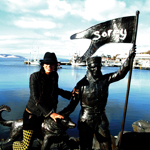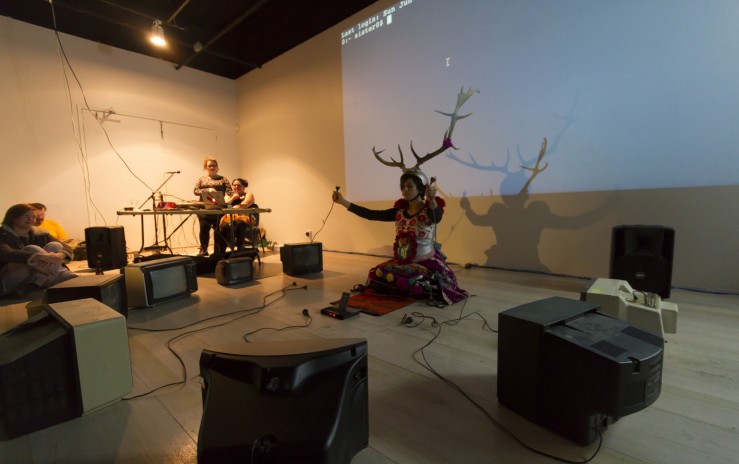Selena de Carvalho (AUS)

The performance and installation (un)popular culture exposed a constructed and documented action where I used a séance mobile app featuring a ‘medium’ attempting to make contact with ‘spirits from the other side’. I attempted to make contact with the lost digital signal PAL (Phase Alternation Line rate) which was recently switched off Australia wide, prompting an influx of analogue Television sets being dumped nationally and the eradication of this signal. The outfit worn consists of Hungarian folk cultural dress from my matriarchal line combined with found and embellished materials to interconnect between digital folk-lore and traditional folk culture.
Responding to the phenomena of Cargo cults (which Wikipedia describes as a kind of Melanesian millenarian movement encompassing a diverse range of practices occurring in the wake of contact with the commercial networks of colonizing societies). The name derives from the apparent belief that various ritualistic acts will lead to a bestowing of material wealth ("cargo"), this work explores the distance and the tension between technology and the voracious desire for technology, attempting to invoke a compelling sense of familiarity and strangeness. Installation and live action become a sensory instrument. I wanted to offer the viewer a chance to perceive both something of themselves in the work and something other.
Selena de Carvalho is a Tasmanian based cross-disciplinary artist. Her practice traverses traditional and new media, printmaking, design for installation and live performance. She has exhibited regularly both locally and nationally in artist run spaces, public and commercial galleries in a solo, collaborative and collective capacity. During 2012 Selena was mentored by Raef Sawford through Jump (the Australia Council's national mentoring program) and was awarded an Australia Council ArtStart Grant. She travelled to China in August of the same year to undertake a 24HR Art residency at the Huantei Art City, Beijing.
In 2013 she was the recipient of the Arts Tasmania Dombrovskis Award and designed Shadow Dreams for Terrapin Puppet Theatre (in partnership with the Tasmanian Symphony Orchestra and Tasmanian Palowa community), which premiered as part of the Ten Days on the Island Festival. Following this she participated in Performance Incubator (a master class with New York based Elevator Repair Service) and also completed an internship with Magnificent Revolution, a pop-up pedal powered cinema collective.
Selena’s work responds to personal notions of ecology and human interaction with the environment, with a focus on work that aspires to raise questions as opposed to provide answers
Responding Artist
(un)popular culture
Artist Text Response
The gathering of international, national and local artists and theorists drawn together for NAF:TMFC workshops, presentations and performances was both intriguing and engaging while also being highly informative. The depth of information shared across different platforms from the reading room and the mailing list, to the workshops, speakers, performances, exhibition and artistic response/critical feedback, led to a hot house of thoughts, ideas and actions. The conversations, new connections and exchanges that took place in and around the curated event were a valuable extension of the ideas and topics introduced throughout the project.
The Tasmanian based artists and geeks who attended the Julian Oliver and Danja Vasiliev Net_Workshop were a diverse range of discipline, age and gender. This mix was an exciting melting pot of people and ideas, provoked and guided by the sure presence of Julian and Danja, who were both generous and enabling in the transferal knowledge, insight, process and opinions regarding their approach to media and the inter-web.
I found that I only knew half the people in the room and this gave me chance to grow my connections and develop a renewed enthusiasm for Hobart’s creative community. The cross spectrum of skills and interests also led to there being a flow of skills and support across the workshop. I found that if I didn’t understand a direction or concept, other workshop attendee’s would aid by giving further direction or example, if the facilitator’s where attending to another person. This was hugely enabling as there was so much to learn in a short time, and much of the information was new and therefore, at times abstract. The three-day workshop was fantastic, but I also felt that there was the potential for it to have been longer, as when the workshop came to an end I was just beginning to develop a deeper understanding of the language and tools I was being shown, and the context in which I could apply them.
The opportunity to research and respond to this event by developing new work within my own practice gave the whole event another layer of meaning and application. It also meant I was further engaged in the process. Observing and discovering someone else’s creative process is a great starting point for the conversation of exchange. I appreciated the space to share my progress with peers, to offer and receive critical feedback. This was highly valuable and encouraged the challenge of bringing a new element to my work by holding a live performance. While I am unsure of the success of this, it has been rewarding to have stepped into a new mode of expression (even if it never happens again).
I very much appreciated the opportunity to attend and participate and can see how this experience will continue to enrich my own practice.

(un)popular culture performance still
Photo: Aaron Horsley
(un)popular culture installation shots
Photos: Aaron Horsley